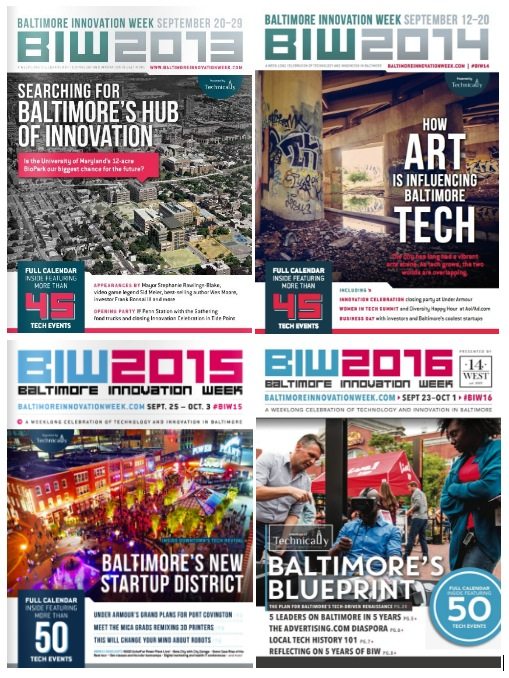One of the goals of a big, annual, collaborative event series like Baltimore Innovation Week, which kicked off last week and runs through this weekend, is to be able to look back and see where we’ve come from.
Each year, we at Technical.ly produce a print magazine (a rarity for this online news site) that features editorial coverage, the week’s calendar of events and logos from the week’s many partners. You can still find this year’s magazine at 50 locations. Like any magazine, it has a cover image that tells a story itself. So let’s understand the growth of Baltimore’s startup and tech scene through five BIW covers.
2012

The first year featured a modest print-out that was aiming to convey one thing: This community was connecting a wonderful mix of efforts. There were the alphabet-soup institutions (ETC, gb.tc and EAGB), established businesses (PayPal and Advertising.com), young companies (Mindgrub, Parking Panda, NewsUp, Event Rebels) and organic community groups and events (Betamore, TechBreakfast and Startup Maryland). These were the early days of a community defining itself. And many of them have stayed involved from the beginning.
2013

For all the organic community growth that still needed to take place, Baltimore most needed to create density and leverage the strength of its institutions. That’s why the emergence of university-based innovation labs was so thrilling. The University of Maryland’s 12-acre BioPark represented among the boldest efforts, not least of all because of its geographic proximity to downtown, a major research school and West Baltimore. It all started with a photograph.
2014

Baltimore’s tech and startup community was finding its way into all corners of the city’s resurgence. That included Baltimore’s noted arts community, well represented by Section 1 (read this profile), the much-hyped outdoor graffiti park under the Jones Falls Expressway that has recently moved forward with its development (more on that in the coming weeks). And that was just one example: visual, performance and other artists were being inspired by and inspiring entrepreneurs, investors and the economic development groups hungry for Baltimore’s future.
2015

Great cities have dense central business districts, where innovators and entrepreneurs can bump into each other walking between lunch and the office. Baltimore’s downtown corridor was going through a renaissance, attracting coworking spaces like the still-evolving Spark and dozens of small, young companies eager to be located in places where their smartest employees wanted to be.
2016

Innovation may very well start in downtown clusters but Baltimore’s neighborhoods need economic impact, too. So the efforts of the tech and startup community have not been untouched by societal and cultural challenges. There is greater awareness to inclusion than ever before. The question remains: Can Baltimore’s tech success can benefit more of its citizens?
Join the conversation!
Find news, events, jobs and people who share your interests on Technical.ly's open community Slack

Baltimore daily roundup: The city's new esports lab; a conference in Wilmington; GBC reports $4B of economic activity

Baltimore daily roundup: Find your next coworking space; sea turtle legislation; Dali raided and sued

Baltimore daily roundup: Johns Hopkins dedicates The Pava Center; Q1's VC outlook; Cal Ripken inaugurates youth STEM center


